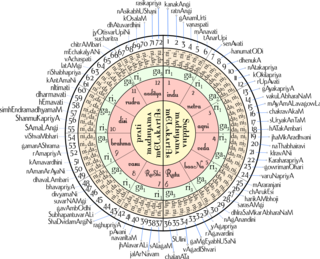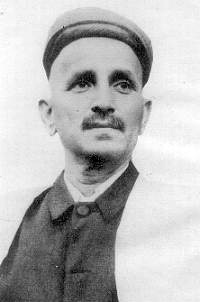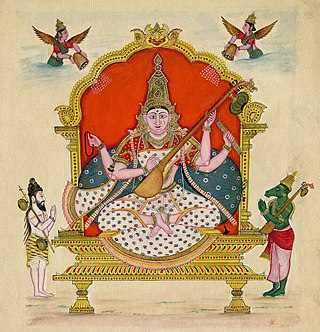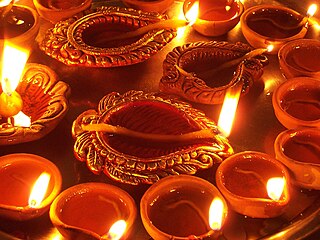
Bhajan refers to any devotional song with a religious theme or spiritual ideas, specifically among Dharmic religions, in any language. The term bhajanam means reverence and originates from the root word bhaj, which means to revere, as in 'Bhaja Govindam' . The term bhajana also means sharing.

A raga is a melodic framework for improvisation in Indian classical music akin to a melodic mode. Rāga is central to classical Indian music. Each rāga consists of an array of melodic structures with musical motifs; and, from the perspective of the Indian tradition, the resulting music has the ability to "colour the mind" as it engages the emotions of the audience.

Indian Classical Music is the classical music of the Indian subcontinent. It is generally described using terms like Shastriya Sangeet and Marg Sangeet. It has two major traditions: the North Indian classical music known as Hindustani and the South Indian expression known as Carnatic. These traditions were not distinct until about the 15th century. During the period of Mughal rule of the Indian subcontinent, the traditions separated and evolved into distinct forms. Hindustani music emphasizes improvisation and exploration of all aspects of a raga, while Carnatic performances tend to be short composition-based. However, the two systems continue to have more common features than differences. Another unique classical music tradition from the eastern part of India is Odissi music, which has evolved over the last two thousand years.

Kirtana, also rendered as Kiirtan, Kirtan or Keertan, is a Sanskrit word that means "narrating, reciting, telling, describing" of an idea or story, specifically in Indian religions. It also refers to a genre of religious performance arts, connoting a musical form of narration, shared recitation, or devotional singing, particularly of spiritual or religious ideas, native to the Indian subcontinent. A person performing kirtan is known as a kirtankara.
Hindustani classical music is the classical music of the Indian subcontinent's northern regions. It may also be called North Indian classical music or Uttar Bhartiya shastriya sangeet. The term shastriya sangeet literally means classical music, and is also used to refer to Indian classical music in general. It is played on instruments like the veena, sitar and sarod. It diverged in the 12th century CE from Carnatic music, the classical tradition of Southern India. While Carnatic music largely uses compositions written in Sanskrit, Kannada, Telugu, Tamil, Malayalam, Hindustani music largely uses compositions written in Hindi, Urdu, Braj, Avadhi, Bhojpuri, Bengali, Rajasthani, Marathi and Punjabi.

The music of West Bengal includes multiple indigenous musical genres such as Baul, Ramprasadi, Bishnupuri Classical, Kirtan, Shyama Sangeet, Rabindra Sangeet, Nazrul Geeti, Dwijendrageeti, Prabhat Samgiita, Agamani-Vijaya, Patua Sangeet, Gambhira, Bhatiali, Bhawaiya, Bengali Rock.
The venu is one of the ancient transverse flutes of Indian classical music. It is an aerophone typically made from bamboo, that is a side blown wind instrument. It continues to be in use in the South Indian Carnatic music tradition. It is referred to as nadi and tunava in the Rigveda and other Vedic texts of Hinduism. In northern Indian music, a similar flute is called bansuri. In the south, it is also called by various other names such as pullanguḻal (புல்லாங்குழல்) in Tamil, oodakuḻal (ഓടകുഴൽ) or kurungu kuḻal in Malayalam (Kerala) and ಕೊಳಲು (koḷalu) or ಮುರಳಿ (muraļi) in Kannada (Karnataka). It is known as pillana grōvi or vēṇuvu (వేణువు) in Telugu. It is also called as Carnatic Flute.
The following list consists of notable concepts that are derived from Hindu culture and associated cultures’ traditions, which are expressed as words in Sanskrit or other Indic languages and Dravidian languages. The main purpose of this list is to disambiguate multiple spellings, to make note of spellings no longer in use for these concepts, to define the concept in one or two lines, to make it easy for one to find and pin down specific concepts, and to provide a guide to unique concepts of Hinduism all in one place.
Gurunath is a commonly used term when praising what is considered by devotees the ultimate source of compassion, love and truth - irrespective of sectarian divides whether they may be devotees of Shiva, the Lord of Transformation in the Hindu pantheon (Shaivaite) or of Vishnu, the Lord of Preservation and Sustenance in the Hindu pantheon (Vaishnav) or any other devotee (bhakta) of a Hindu God or Goddess.

Pandit Vishnu Narayan Bhatkhande was an Indian musicologist who wrote the first modern treatise on Hindustani classical music, an art which had been propagated for centuries mostly through oral traditions. During those earlier times, the art had undergone several changes, rendering the raga grammar documented in scant old outdated texts.

The Saraswati Vandana is a Hindu mantra. It is addressed to the goddess Saraswati, the goddess of knowledge, music, art, speech, wisdom, and learning.
Bhaskar Raghunath Bakhale was a Hindustani classical vocalist, a composer, and a teacher.

The Saraswati Shloka is a Hindu prayer. It is traditionally chanted by a student before their commencement of studies. It is addressed to Saraswati, the Hindu goddess of learning and knowledge.

Worship in Hinduism is an act of religious devotion usually directed to one or more Hindu deities, invoking a sense of Bhakti or devotional love. This term is probably a central one in Hinduism, but a direct translation from the Sanskrit to English is difficult. Worship in Hinduism takes many forms, and its expression vary depending on geographical, linguistic, and cultural factors. Hindu worship is not limited to a particular place and Hindus perform worship in temples and within the home. It often incorporates personal reflection, music, dance, poetry, rituals, and ceremonies. Worship in Hinduism serves various purposes, including seeking blessings, guidance, or specific outcomes, as well as fostering a sense of inner peace and spiritual growth. It can also be an expression of devotion (bhakti) to the deity. The aim is to lead a pure life in order to progress spiritually and eventually attain liberation (moksha) from the cycle of rebirth.

The taal or manjira, jalra, karatala, kartal or gini is a pair of clash cymbals, originating in the Indian subcontinent, which make high-pitched percussion sounds. In its simplest form, it consists of a pair of small hand cymbals. The word taal comes from the Sanskrit word Tālà, which literally means a clap. It is a part of Indian music and culture, used in various traditional customs e.g. Bihu music, Harinaam etc. It is a type of Ghana vadya.

The veena, also spelled vina, is any of various chordophone instruments from the Indian subcontinent. Ancient musical instruments evolved into many variations, such as lutes, zithers and arched harps. The many regional designs have different names such as the Rudra veena, the Saraswati veena, the Vichitra veena and others.

Shanno Khurana is an Indian classical vocalist and composer, from the Rampur-Sahaswan gharana of Hindustani classical music. A disciple of the doyen of the gharana, Ustad Mushtaq Hussain Khan, she is known for performing rare bandish and raag, though her singing style includes genres like khayal, tarana, thumri, dadra, tappa, to chaiti and bhajan. Born and brought up in Jodhpur, she started singing on All India Radio in 1945 in Lahore, later shifted to Delhi, where she continued her singing on All India Radio, Delhi and in concerts and music festivals. She also pursued music education, finally earning her M.Phil. and PhD in music from the Kairagarh University, and has undertakes extensive research on folk music of Rajasthan.

Krishnaji Ganesh Phulambrikar (1898–1974), popularly known as Master Krishnarao, was a musical genius - an Indian vocalist, classical musician and composer of Hindustani music. He was credited with the creation of three Hindustani ragas and several bandishes. Phulambrikar, a recipient of the Sangeet Natak Akademi Fellowship, was also the music composer of several movies, including Dharmatma, a 1935 Hindi film starring Bal Gandharva, a renowned Marathi singer and Padosi, a 1941 directorial venture of V. Shantaram. The Government of India awarded him the third highest civilian honour of the Padma Bhushan, in 1971, for his contributions to music.
Sanātanī is a modern term used to describe Hindu duties that incorporate teachings from the Vedas, Upanishads, Puranas, and other Hindu religious texts and scriptures such as the Ramayana and its many versions, as well as the Mahabharata, which itself is often described as a concise guide to Hindu philosophy and a practical, self-contained guide to life. The word Sanātanī is coined from Sanātana Dharma which refers to the idea that its origins lie beyond human history, as revealed in the Hindu texts.

South Asian music comprises a range of prominent musical genres and styles that are unique to the countries in and around the Indian subcontinent. This subregion of Asia includes countries such as Afghanistan, Bangladesh, Bhutan, India, Maldives, Nepal, Pakistan, and Sri Lanka, with each region one possessing its own distinct musical traditions. South Asian styles of music reflect a diverse range of local customs, regional languages and historical traditions, that have shaped the musical practices which are still seen today. Throughout history, South Asian musicians have emulated religious and spiritual beliefs into their compositions, resulting in the creation of musical styles such as Qawwali, Ghazal and Hindustani classical music. The development of forms of mass media in the 1980s and 1990s contributed to a new type of South Asian musical culture, as the rise of cinema and television resulted in the popularity of genres such as Bollywood and Lollywood. As a result of social media and modern streaming networks, folk and ritual music styles are still widely appreciated today, with many modern artists taking inspiration from the classical traditions that defined the history of South Asian music.














